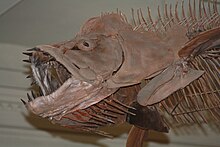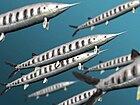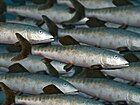Xiphactinus
| Xiphactinus | |
|---|---|
 | |
| Mounted skeleton of X. audax at the American Museum of Natural History | |
| Scientific classification | |
| Domain: | Eukaryota |
| Kingdom: | Animalia |
| Phylum: | Chordata |
| Class: | Actinopterygii |
| Order: | †Ichthyodectiformes |
| Family: | †Ichthyodectidae |
| Subfamily: | †Ichthyodectinae |
| Genus: | †Xiphactinus Leidy, 1870 |
| Type species | |
| †Xiphactinus audax Leidy, 1870 | |
| Species[1] | |
| |
| Synonyms | |
| |
Xiphactinus (from Latin and Greek for "sword-ray") is an extinct genus of large predatory marine bony fish that lived during the late Albian to the late Maastrichtian.[4] The genus grew up to 5–6 metres (16–20 ft) in length, and superficially resembled a gargantuan, fanged tarpon.[1][5] It is a member of the extinct order Ichthyodectiformes, which represent close relatives of modern teleosts.
The species Portheus molossus described by Cope is a junior synonym of X. audax. Skeletal remains of Xiphactinus have come from the Carlile Shale and Greenhorn Limestone of Kansas (where the first Xiphactinus fossil was discovered during the 1850s in the Niobrara Chalk),[6][7] and Cretaceous formations all over the East Coast (most notably Georgia, Alabama, North Carolina, and New Jersey) in the United States,[6][3] as well as Europe, Australia,[8] the Kanguk and Ashville Formations of Canada,[6] La Luna Formation of Venezuela and the Salamanca Formation in Argentina.[6][4][9]
Paleobiology
[edit]
Species of Xiphactinus were voracious predatory fish. At least a dozen specimens of X. audax have been collected with the remains of large, undigested or partially digested prey in their stomachs. In particular, one 4.2 metres (14 ft) fossil "Fish-Within-A-Fish" specimen was collected by George F. Sternberg with another, nearly perfectly preserved 1.9 metres (6.2 ft) long ichthyodectid Gillicus arcuatus inside of it. The larger fish apparently died soon after eating its prey, most likely owing to the smaller prey's struggling and rupturing an organ as it was being swallowed. This fossil is on display at the Sternberg Museum of Natural History in Hays, Kansas.[10]
Like many other species in the Late Cretaceous oceans, a dead or injured individual was likely to be scavenged by sharks (Cretoxyrhina and Squalicorax). The remains of a Xiphactinus were found within a large specimen of Cretoxyrhina collected by Charles H. Sternberg. The specimen is on display at the University of Kansas Museum of Natural History.

Like modern tarpons, Xiphactinus likely spent its juvenile stage of life in shallow seaway margins for protection and to utilize rich food resources, possibly rare in open marine water, though this needs confirmation due to the lack of shallow, nearshore deposits from the Western Interior Seaway. The teeth of the juvenile specimen indicate that the diet of Xiphactinus probably didn't change notably during its growth, implying that even the small specimens would have been fish-eating predators.[11]
"Unicerosaurus"
[edit]In 1982, a former Baptist minister, Carl Baugh, began excavations on the limestone beds of the Paluxy River, near Glen Rose, Texas, famous for its dinosaur tracks. Some of the tracks resembled human footprints and had been proclaimed since 1900 as evidence that dinosaurs and modern humans had once lived alongside one another. Scientists' investigations found the supposed human footprints to be "forms of elongate dinosaur tracks, while others were selectively highlighted erosional markings, and still others (on loose blocks) probable carvings." While excavating, he found a solitary "Y-shaped" fossil that he informally called "Unicerosaurus". In a 1987 popular article, John Armstrong described the fossil as a "Y-shaped petrified bone that appears to be the neural spine from a huge fish like the Portheus of Niobrara Chalk" that Baugh's museum "declared to be the forehead horn of a newly discovered dinosaur genus".[12] The museum's exhibit told visitors that the "horn" belonged to "the unicorn of Job 38, one of three dinosaurs mentioned in Scripture; the others being behemoth and leviathan of Job 40 and 41", and that the horn was able to fold back like the blade of a jack knife. Although some Young Earth Creationists shared Baugh's interpretations of the biblical Behemoth and Leviathan, Baugh's claims were not taken seriously either by Christian organizations or the scientific community.[citation needed]
In popular culture
[edit]

In October 2010, Kansas House Rep. Tom Sloan (R-Lawrence) announced that he would introduce legislation to make Xiphactinus audax, a.k.a. the "X-fish", the state fossil of Kansas.[13] Ultimately, Tylosaurus was selected instead.[14][15]
Notes
[edit]References
[edit]- ^ a b Vavrek, M.J.; Murray, A.M.; Bell, P.R. (2016). "Xiphactinus audax Leidy, 1870 from the Puskwaskau Formation (Santonian to Campanian) of northwestern Alberta, Canada and the distribution of Xiphactinus in North America". Vertebrate Anatomy Morphology Palaeontology. 1 (1): 89–100. doi:10.18435/B5H596.
- ^ Bardack, D. (1965). "Anatomy and evolution of chirocentrid fishes". The University of Kansas Paleontological Contributions. 10: 1–88. hdl:1808/3814.
- ^ a b Schwimmer, David R.; Stewart, J. D.; Williams, G. Dent (1997). "Xiphactinus vetus and the Distribution of Xiphactinus Species in the Eastern United States". Journal of Vertebrate Paleontology. 17 (3): 610–15. Bibcode:1997JVPal..17..610S. doi:10.1080/02724634.1997.10011007. JSTOR 4523841.
- ^ a b De Pasqua, Julieta J.; Agnolin, Federico L.; Bogan, Sergio (2020). "First record of the ichthyodectiform fish Xiphactinus (Teleostei) from Patagonia, Argentina". Alcheringa: An Australasian Journal of Palaeontology. 44 (2): 327–331. Bibcode:2020Alch...44..327D. doi:10.1080/03115518.2019.1702221. S2CID 216170146.
- ^ Lionel Cavin; Peter L. Forey; Samuel Giersch (2013). "Osteology of Eubiodectes libanicus (Pictet & Humbert, 1866) and some other ichthyodectiformes (Teleostei): phylogenetic implications". Journal of Systematic Palaeontology. 11 (2): 115–177. doi:10.1080/14772019.2012.691559. S2CID 83807640.
- ^ a b c d Xiphactinus at Fossilworks.org
- ^ Haines, Tim; Chambers, Paul (2005). The complete guide to prehistoric life (First ed.). Buffalo, N.Y.: Firefly Books. p. 134. ISBN 978-1-55407-181-4.
The first Xiphactinus fossil was found during the 1850s in Kansas.
- ^ Vavrek, Matthew J.; Murray, Alison M.; Bell, Phil R. (2016-02-04). "Xiphactinus audax Leidy 1870 from the Puskwaskau Formation (Santonian to Campanian) of northwestern Alberta, Canada and the distribution of Xiphactinus in North America". Vertebrate Anatomy Morphology Palaeontology. 1: 89. doi:10.18435/B5H596.
- ^ Carrillo-Briceño, J., Alvarado-Ortega, J. & Torres, C. (2012). Primer registro de Xiphactinus Leidy, 1870, (Teleostei: Ichthyodectiformes) en el Cretácico Superior de América del Sur (Formación La Luna, Venezuela). Revista Brasileira de Paleontologia 15(3):327-335
- ^ Konishi, T., Newbrey, M. G., & Caldwell, M. W. (2014). A small, exquisitely preserved specimen of Mosasaurus missouriensis (Squamata, Mosasauridae) from the upper Campanian of the Bearpaw Formation, western Canada, and the first stomach contents for the genus. Journal of Vertebrate Paleontology, 34(4), 802–819. https://doi.org/10.1080/02724634.2014.838573
- ^ James L. King; Kristopher J. Super (2019). "The smallest recorded specimen of Xiphactinus audax from the Niobrara Chalk of Kansas and its implications for juvenile ichthyodectid ecology". Historical Biology: An International Journal of Paleobiology. 33 (4): 441–445. doi:10.1080/08912963.2019.1623212. S2CID 191146942.
- ^ Armstrong, John R. (1987). Creation/Evolution Newsletter 7 5:21; Geolog. 16, Part 4.
- ^ "Kansas Rep. Tom Sloan agrees to back X-fish as state's official fossil / LJWorld.com". .ljworld.com. Associated Press. 2010-10-26. Retrieved 2011-10-12.
- ^ "State Fossils - Kansapedia - Kansas Historical Society".
- ^ "List of State Fossils". State Symbols, State Fossil. Fossilera. Retrieved September 1, 2015.
External links
[edit]- Carnegie Museum Archived 2004-11-14 at the Wayback Machine
- Oceans of Kansas
- a painting and information Archived 2007-09-28 at the Wayback Machine
- BBC
- Canadian Fossil Discovery Centre Archived 2011-07-10 at the Wayback Machine


 French
French Deutsch
Deutsch








